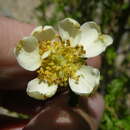More info for the terms:
forest,
grassland,
habitat type,
natural,
shrub,
shrubland,
tree,
woodlandPlant communities with Stansbury cliffrose include pinyon-juniper
(Pinus-Juniperus spp.) woodland; dry-site, open ponderosa pine (P.
ponderosa var. ponderosa) and Arizona pine (P. ponderosa var. arizonica)
forest; mountain brushland; salt and other desert shrublands; and desert
shrubland-desert grassland ecotones. Plant species commonly associated
with Stansbury cliffrose are listed below.
Pinyon-juniper - Utah juniper (J. osteosperma), alligator juniper (J.
deppeana), California juniper (J. californica), pinyon (P. edulis),
shrub live oak (Quercus turbinella), Apache plume, desert sweet
(Chamaebatiaria millefolium), agarito (Mahonia trifoloilata), banana
yucca (Yucca baccata), Joshua tree (Y. brevifolia), Opuntia spp., New
Mexico needlegrass (Stipa neomexicana), bottlebrush squirreltail (Elymus
elymoides), blue grama (Bouteloua gracilis), fringed sagebrush
(Artemisia frigida), and Louisiana sagewort (A. ludoviciana) [
3,
4,
34,
48].
Ponderosa and Arizona pines - antelope bitterbrush, Gambel oak (Q.
gambelii), Oregon-grape (M. repens), blue grama, mountain muhly
(Muhlenbergia montana), and Arizona threeawn (Aristida arizonica)
[
14,
31,
48].
Mountain brushland - mountain snowberry (Symphoricarpos oreophilus),
Utah serviceberry (Amelanchier utahensis), Louisiana sagewort, Sandberg
bluegrass (Poa secunda), and sand dropseed (Sporobolus cryptandrus) [
13,
66].
Desert shrubland - fourwing saltbush (Atriplex canescens), green
ephedra (Ephedra viridis), broom snakeweed (Gutierrezia sarothrae), big
galleta (Hilaria rigida) [
103], bluebunch wheatgrass (Pseudoroegneria
spicata), and cheatgrass (Bromus tectorum) [
12].
Vegetation classifications describing Stansbury cliffrose as a plant community
dominant are:
A preliminary classification of the natural vegetation of Colorado [
3]
Forest and woodland habitat types (plant associations) of Arizona south
of the Mogollon Rim and southwestern New Mexico [
4]
Vegetation and soils of Pine and Mathews Canyon Watersheds [
7] (NV)
A habitat type classification system for ponderosa pine forests of
northern Arizona [
31]
Forest and woodland habitat types (plant associations) of northern New
Mexico and northern Arizona [
48]
Habitat and community relationships of cliffrose (Cowania mexicana var.
stansburiana) in central Utah [
66]

